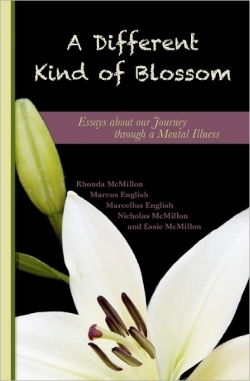A Different Kind of Blossom
Essays About Our Journey Through a Mental Illness
People suffering from mental illness experience inexplicable emotions that cause them to act strangely. In this fragile state, they often encounter negative reactions to their behavior from people around them. No wonder denial of diagnosis might tempt the patient and her friends and family. The more positive choice for everyone involved is to learn about the mental illness and how to manage its symptoms.
A Different Kind of Blossom describes one family’s efforts to understand this process. After receiving a diagnosis of Schizoaffective Disorder, Depressive Type, Rhonda McMillon first tried denial. With the support of her mother, Essie McMillon, twin sons, Marcus and Marcellus English, and younger son, Nicholas McMillon, she learned to accept the illness and monitor her own behavior. Relying on professional advice and their Christian faith, they gradually healed their fractured family. Daily writing sessions also helped them. The family has published the resulting essays in hopes of encouraging others who face mental health challenges.
Rhonda and her three sons share a home in Valparaiso, Indiana. Marcus and Marcellus both study mechanical engineering at Purdue University North Central. Nicholas attends the local high school and practices martial arts. Through her work as a social worker, Essie is familiar with mental health issues.
Rhonda usually retreated to her bedroom during emotional outbursts. Frustrated by a misunderstanding with Marcus, she sought solace by listening to jazz and writing. Concerned for her welfare, the twins came in the room to console her. Rhonda writes, “As we held on to one another, a flicker of joy spread out like warm candlelight from my heart. Is this what love feels like?”
Marcus worried about his reactions to Rhonda, recognizing that his mother’s erratic behavior challenged his ability to love her. He learned to adjust his tendency to blame her for not controlling the symptoms better. “Although I still have to admit that once you get to know Schizoaffective Disorder, you do not always like what it brings to the family tree,” Marcus confesses.
Essie regrets that she did not pay more attention to her daughter’s struggles, which intensified when Rhonda reached adulthood. As the symptoms grew more acute, Essie took action to help her troubled daughter and grandchildren. She says, “I also needed to make sure Marcus, Marcellus, and Nicholas were supported and teach them how to be supportive of their mother as well as one another.”
The McMillon/English family writes honestly about the challenges they faced as each individual learned to cope with a loved one suffering from mental illness. The final chapter contains Essie’s noteworthy suggestions for practical steps readers can take to implement the healing process. This authentic narrative occasionally founders when awkward phrasing confuses the writer’s message. Grammatical errors and word mix-ups, such as initialize instead of initiate and isles for aisles, were also noted.
The essayists’ heartfelt accounts of surviving Rhonda’s health crisis shows readers how family dynamics, ruptured by mental illness, can be diverted in a more positive direction.
Reviewed by
Margaret Cullison
Disclosure: This article is not an endorsement, but a review. The publisher of this book provided free copies of the book and paid a small fee to have their book reviewed by a professional reviewer. Foreword Reviews and Clarion Reviews make no guarantee that the publisher will receive a positive review. Foreword Magazine, Inc. is disclosing this in accordance with the Federal Trade Commission’s 16 CFR, Part 255.

